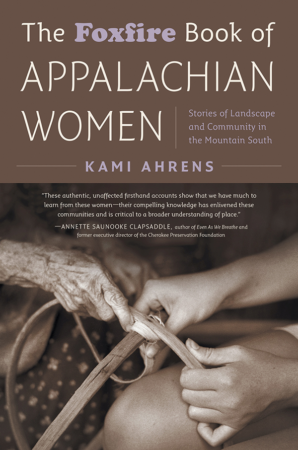You can’t imagine life without your devices.
Your cell phone, your computer: how else would you stay in touch, take photos, end arguments, keep documents? You need those links to civilization, you panic when you don’t have them. So what would you do, absent all modern conveniences? In “The Foxfire Book of Appalachian Women,” edited by Kami Ahrens, you’ll find out.
Nearly sixty years ago, a “group of rowdy high school students” in a small town in Georgia “decided to create a literary magazine” filled with stories, poetry, and instruction from their elders in rural Appalachia. Every year since 1966, a new batch of students has gone back to collect more stories of life as it used to be.
This book, says editor Kami Ahrens, springs from “the Foxfire archives… going back to the roots of the organization.” Here, Ahrens lets women tell their stories alone.
Land — both ownership and stewardship — rings loud in these narratives, with frequent remarks about loss of property through hard times, and nothing to pass on to future generations. Issues of transportation arise, too: many of these women remembered walking everywhere. Margaret Burrell Norton said she was a teenager when she saw her first car.
Though an occasional tale of homemade toys or silly pranks surfaces, most women spoke about working hard, with very little playtime. Hard work had history, too: Beulah Perry’s grandfather was a slave before she was born; Carrie McDonnell Stewart’s father often repeated the story of his sale on a slave block.
After her father abandoned her when she was just 11 years old, Carolyn Jones Stradley was completely on her own. Maude Conley Shope said that until “we was great big young’uns,” she and her siblings believed in Santa Claus. Modern medicine was all but nonexistent. Marriages happened early, lasted long, and family sizes were generally in the double-digits. Poverty was a common theme in these stories, and times were tough but in a crisis, people never forgot their neighbors…
The internet is down, you have one bar on your phone, and there’s nothing on TV. Which is the perfect time to have “The Foxfire Book of Appalachian Women” in your lap.
The first thing you’ll notice about the stories in this book is that, while there are a handful of modern profiles here, many of the interviewees are gone today — most having lived long lives before dying decades ago. Their presence in this book underscores a reason for what’s here: that the ways people lived in the early half of the last century — the social customs, poverty, make-do attitudes, religious beliefs, resourcefulness, matriarchal strengths, and family life — will be forever lost unless they’re captured now.
Readers, in fact, will be glad these were.
Unique to this book in the Foxfire series is that this is all about women, making it appealing to adult historians, homesteaders, back-to-the-land-ers, and feminists, as well as to high schoolers of the same age as the original story-gatherers. For you, skipping “The Foxfire Book of Appalachian Women” should be unimaginable.
“The Foxfire Book of Appalachian Women, “ edited by Kami Ahrens
c.2023, The University of North Carolina Press
$25.00
288 pages




